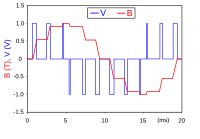
Photo from wikipedia
Coupling charge impurity scattering effects and charge‐carrier modulation by doping can offer intriguing opportunities for atomic‐level control of resistive switching (RS). Nonetheless, such effects have remained unexplored for memristive applications… Click to show full abstract
Coupling charge impurity scattering effects and charge‐carrier modulation by doping can offer intriguing opportunities for atomic‐level control of resistive switching (RS). Nonetheless, such effects have remained unexplored for memristive applications based on 2D materials. Here a facile approach is reported to transform an RS‐inactive rhenium disulfide (ReS2) into an effective switching material through interfacial modulation induced by molybdenum‐irradiation (Mo‐i) doping. Using ReS2 as a model system, this study unveils a unique RS mechanism based on the formation/dissolution of metallic β‐ReO2 filament across the defective ReS2 interface during the set/reset process. Through simple interfacial modulation, ReS2 of various thicknesses are switchable by modulating the Mo‐irradiation period. Besides, the Mo‐irradiated ReS2 (Mo‐ReS2) memristor further exhibits a bipolar non‐volatile switching ratio of nearly two orders of magnitude, programmable multilevel resistance states, and long‐term synaptic plasticity. Additionally, the fabricated device can achieve a high MNIST learning accuracy of 91% under a non‐identical pulse train. The study's findings demonstrate the potential for modulating RS in RS‐inactive 2D materials via the unique doping‐induced charged impurity scattering property.
Journal Title: Advanced Materials
Year Published: 2022
Link to full text (if available)
Share on Social Media: Sign Up to like & get
recommendations!